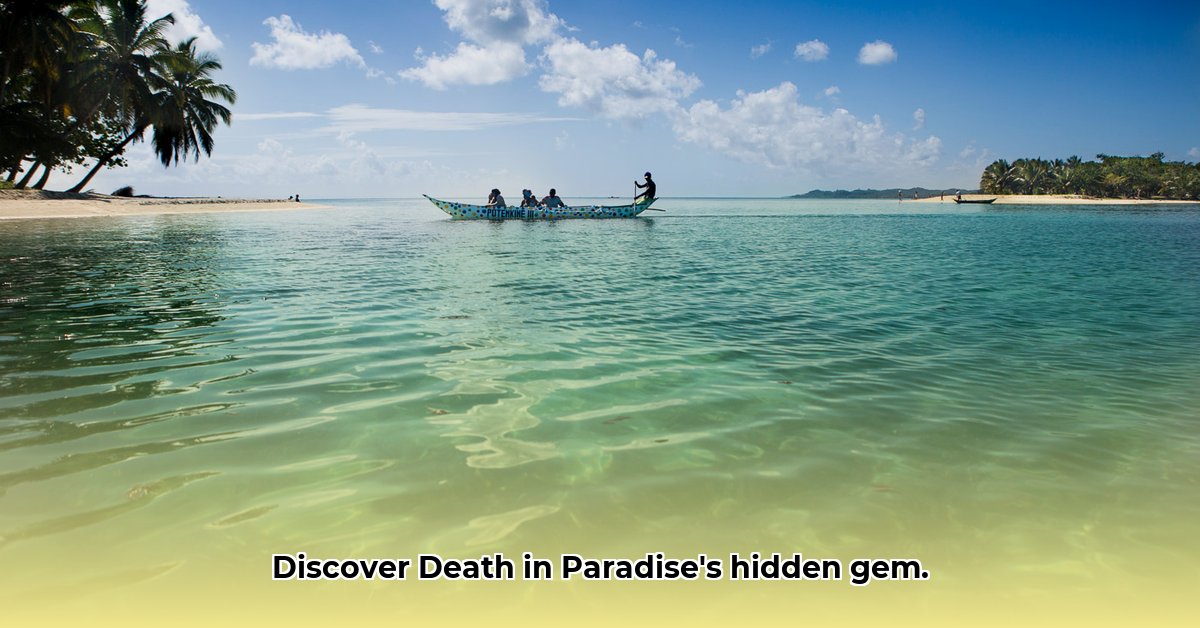Ever wondered where they film that awesome show, “Death in Paradise?” It’s not a made-up island; it’s Deshaies, Guadeloupe! This article takes you behind the scenes, showing you the real-life locations that make up the fictional Sainte Marie. We’ll explore the stunning scenery, the ups and downs of filming in paradise, and how the show has changed tourism on the island. Get ready to discover the secrets of “Death in Paradise,” from the challenges of filming in a tropical paradise to the amazing impact the show’s had on Guadeloupe. We’ll even give you some tips on planning your own visit! Learn more about this amazing island at Sainte Marie details.
Discovering Sainte Marie Island: The Real-Life ‘Death in Paradise’ Caribbean Paradise
Sainte Marie Island, the idyllic setting for the beloved TV show Death in Paradise, isn’t just a figment of television magic. It’s brought to life by the stunning real-world location of Deshaies, Guadeloupe – a captivating Caribbean jewel beaming directly onto screens worldwide. This article delves into the captivating story of how this charming island became a television star, examining specific filming locations, the behind-the-scenes realities, and the show’s significant impact on local tourism and culture. Prepare to uncover the secrets of this authentic tropical paradise!
Iconic Locations: Stepping into the World of ‘Death in Paradise’
The show’s creators expertly integrate Deshaies into the fictional Sainte Marie. The sun-drenched sands of Anse de la Perle beach aren’t merely scenic; they frequently provide the backdrop for resolving pivotal plot points. Imagine the detective piecing together clues against the backdrop of the turquoise Caribbean Sea – pure escapism! The Langley Resort Fort Royal, a real-life luxury hotel, provides the perfect setting for the show’s more sophisticated scenes. Even the daily life of Deshaies – the vibrant market, the colorful shops, and the welcoming cafes that line the waterfront – play key roles in shaping the island’s distinctive character. These aren’t just background details; they’re integral to crafting the unique atmosphere that resonates with Death in Paradise viewers worldwide. The selection of these locations involves a collaborative effort between the production team, local guides, and authorities, ensuring both visual splendor and logistical practicality. Each location contributes uniquely to the show’s distinct feel, but what impact does this have on local life?
Behind the Camera: Overcoming Challenges While Capturing Paradise
Filming a television show in a tropical paradise might seem like a dream job, but it’s a demanding undertaking filled with unique obstacles! The production crew faces significant challenges on a daily basis. Unpredictable weather patterns, including intense tropical storms and the relentless Caribbean sun, can easily disrupt filming schedules. The ever-changing tides impact shooting locations and set construction. Imagine the challenge of erecting a temporary beach shack for the detective, only to dismantle it swiftly before high tide! Resourcefulness is essential. The police station, central to the show’s narrative, cleverly utilizes the priest’s office and the community church hall, showcasing the crew’s creativity and adaptability. To ensure a disruption-free shoot, the production team coordinates closely with local authorities, obtaining necessary permits and adhering to environmental regulations. What strategies do they employ to mitigate the impact of weather and other unforeseen challenges?
Tourism’s Impact: Balancing Economic Boons with Environmental concerns
Death in Paradise‘s international popularity undeniably elevates Deshaies’ profile on the global tourism stage. However, how significant is this impact, and is it sustainable? While the town experiences a noticeable buzz from visiting fans, quantifying the precise economic impact remains intricate. Cruise excursions now incorporate stops at recognizable filming locations, offering a glimpse of the on-screen world. Dedicated Death in Paradise tourism, while present, isn’t the dominant economic force. This situation presents both opportunities and potential risks. Leveraging the show’s popularity could stimulate the local economy, but it also raises the specter of overtourism, potentially straining the island’s delicate ecosystem. Collaboration between local authorities, businesses, and environmental organizations is crucial to developing and implementing sustainable tourism practices. These practices should aim to minimize environmental impact, preserve local culture, and ensure that economic benefits are distributed equitably across the community. What specific measures can be adopted to mitigate overtourism and promote responsible travel?
Assessing the Future: Sustainable Development and the Long-Term Vision
Let’s examine the potential impacts across diverse stakeholders and timeframes. While short-term benefits are evident, the long-term implications require careful consideration. The following table provides a general overview of stakeholders and the interplay between short-term and long-term impacts. It is essential to consider that these are estimates and may vary.
| Stakeholder | Short-Term Impact (0-1 year) | Long-Term Impact (3-5 years) |
|---|---|---|
| Guadeloupe Tourism Board | Increased international visibility; focused marketing campaigns highlighting “Death in Paradise” locations | Potential surge in tourism infrastructure; need for marketing diversification to appeal to a broader range of travelers; brand recognition nationally |
| Film Production Companies | Economic infusion into the community; creation of short-term employment opportunities in Deshaies | Ongoing opportunities for collaborative projects; potential commitment to sustainable production practices, benefiting the local community and its image |
| Local Businesses in Deshaies | Increase in customer foot traffic and revenue during filming and tourist visits | Diversification of business models to cater to a wider range of tourist interests; infrastructure improvements to accommodate increased tourism; training programs to improve customer service |
| Residents of Deshaies | Creation of short-term employment opportunities during filming; potential for rental income | Balanced access to economic benefits; preservation of cultural heritage; promotion of community inclusion in tourism planning initiatives |
This table underscores the inherently intertwined relationships between the show, the island, and sustainable tourism practices. Concerted planning among local government, area businesses, and the production company is critical to maximizing economic benefits while simultaneously minimizing environmental strains and safeguarding the island’s unique identity for generations to come. Ongoing research to assess the tourism impact is essential for effective long-term planning. What specific initiatives can residents undertake to ensure their active participation in tourism-related decisions?
The Enduring Appeal of Sainte Marie Island
The success of Death in Paradise and its connection to Sainte Marie Island (Deshaies) provides a compelling case study of the complex ties between television productions, tourism, and ecological sustainability. The consensus among experts is that the island will likely continue to reap benefits from heightened exposure, but strategic planning and responsible management are paramount to achieving long-term prosperity and minimizing potential negative consequences. How can Deshaies leverage its fame to create a more diversified and resilient economy?
Measuring Film Tourism’s Economic Footprint in Deshaies, Guadeloupe
- The economic effects of film tourism are multifaceted and require comprehensive measurement techniques.
- Oversimplified calculations fail to capture the full effects; an integrated approach is necessary.
- A variety of measurement methodologies exist, each possessing inherent strengths and weaknesses.
Deconstructing the “Death in Paradise” impact
Deshaies, Guadeloupe, a stunning Caribbean paradise, achieved worldwide recognition as the backdrop for the fictional Sainte Marie in the acclaimed TV series, Death in Paradise. But how has this cinematic spotlight translated into concrete economic advantages? This question prompts us to examine how to measure the economic impact of film tourism in Deshaies, Guadeloupe. The answer is complex as economic effects are diverse.
A Multifaceted Approach to Quantifying Impact
Quantifying the economic impact involves more than just tallying tourist spending; it requires understanding the ripple effects throughout the local economy. Film tourism’s influence expands concentrically, touching numerous sectors.
Direct Impacts: These are the most readily measured. They encompass immediate spending by the production crew, actors, and visitors directly attributed to the show. This includes expenditures on lodging, food, transportation, and local experiences.
Indirect Impacts: These involve the economic activity generated by local businesses that supply goods and services to those involved in filming and tourism. This includes catering companies, equipment rental firms, and transportation providers.
Induced Impacts: These are the longer-term effects stemming from the increased income and spending of individuals employed in sectors directly and indirectly impacted by film tourism. This could include a carpenter who builds sets for the show spending money at a local market, or a restaurant worker using their wages to purchase goods and services. What qualitative data is needed to effectively measure all direct costs and benefits?
Navigating Data Challenges and Methodologies
Accurately measuring these impacts poses several challenges. How to measure the economic impact of film tourism in Deshaies, Guadeloupe requires sophisticated quantitative and qualitative methods. While simple multiplier effect calculations offer a starting point, they don’t fully capture the nuances. More robust models, such as Input-Output analysis, tracking the flow of goods and services between various economic sectors, and Computable General Equilibrium (CGE) models, simulating the entire economy, provide a more comprehensive understanding. Furthermore, measuring the less tangible benefits requires robust qualitative approaches.
Even the most sophisticated methods have limitations. Accurately determining the “additionality” (expenditure uniquely attributable to the show) of tourism spending is challenging. Leakages, representing money flowing out of the local economy (e.g., if the production company is international or tourists purchase imported goods), need to be carefully considered. What percentage of Deshaies tourism revenue originates from foreign ownership or imports?
Beyond the Quantitative: Measuring Intangible Cultural Benefits
While quantitative data is essential, the full impact also hinges on qualitative factors. Increased brand recognition










